

 - for some intense perilous action and brief strong language.
- for some intense perilous action and brief strong language.
With our time on Earth coming to an end, a team of explorers undertakes the most important mission in human history; traveling beyond this galaxy to discover whether mankind has a future among the stars.
Directed and co-written by Christopher Nolan (Inception, The Dark Knight Trilogy), the production will travel the globe and utilize a mixture of 35mm anamorphic and IMAX film photography to bring to the screen a script based on the combination of an original idea by Nolan and an existing script by Jonathan Nolan, originally developed for Paramount Pictures and producer Lynda Obst. (from MovieWeb.com)
For about 7 years, the name "Christopher Nolan" was pretty synonymous with "Batman" as the indie director helmed a trilogy of films that showcased the caped crusader as "The Dark Knight." In between his Batman films, Nolan presented two side projects that were puzzlers in their own right, the dark exploration of the effects of seeking revenge in The Prestige, and the crime drama set in the world of dreams, Inception. And with the Batman saga conclusion in 2012's The Dark Knight Rises, Nolan fans were left wondering what the acclaimed director would do next.
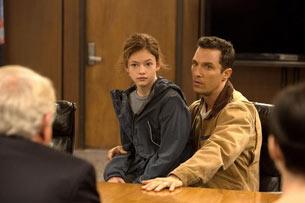
Nolan got his feet wet in the indie world, turning heads with the R-rated Memento and its equally dark but less impressive Insomnia, before delving into the realm of the blockbuster with Batman Begins and never looking back. But the fun thing about a Nolan blockbuster is that it often defies what makes a blockbuster a blockbuster. For example, Inception had lots of twists and turns with multiple storylines happening at once, not to mention a resolution at the end that left things open-ended enough to anger some, but it created great conversation once the credits began to roll and it left many viewers thinking about the story for days afterward. Nolan movies aren't just your traditional "popcorn film."
Enter Interstellar. If there's ever a film to tick off the blockbuster movie fan it's this one. At 11 minutes shy of a three-hour running time, this sci-fi drama doesn't have hobbits, dragons, or monsters to try to justify a gratuitously long running time (I could also mention "giant robots," but no excuse Michael Bay can offer will justify the Transformers movie lengths). Instead, Nolan uses every minute -- for better or for worse -- to paint a picture and tell the story. It's set in our world, but in a not-so-distant future where the earth is becoming less and less inhabitable due to huge dirt storms and food becoming scarce. This inspires NASA to lead an expedition into space to find a solution or colonize elsewhere. It becomes loaded with theories and jargon about gravity, theories of relativity and wormholes, but it never gets entirely lost in it either. (It may start sounding a bit too much like an episode of Star Trek: The Next Generation for some viewer though.) The Nolan brothers--who co-wrote the film together--use the running time to flesh out the story and not let it get buried under a hurried plot or incredible visuals -- which it has plenty of the latter.
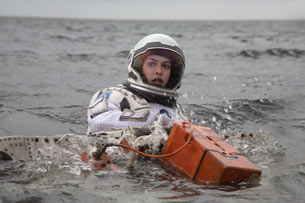
Matthew McConaughey leads a star-studded cast with intensity as Cooper. He's got a great everyday man personality to him, and his southern drawl is right at home as a farmer who used to be a pilot in the service and agrees to head up the expedition into space, if it means the possibility of ensuring a future for his children. McConaughey just plain knocks it out of the park in this film. Anne Hathaway is pretty good as well as a scientist who joins McConaughey into space, and Michael Caine delivers his usual trusty performance with one moment in particular that's truly moving and incredible. Casey Affleck and Matt Damon have smaller roles, but do a lot with the time they're given. Finally, Jessica Chastain is wonderful as an adult Murph Cooper. Nolan does a really great job in making his characters feel consistent as they "age" during the film, and actors like Chastain and Affleck really make it feel like a natural process. It's not hard to believe Affleck and Chastain are the grown up versions of Coop's kids.
The story is another Nolan "onion" of sorts, with lots of layers to unpeel and discuss after viewing. Its slow pacing will wear on the casual viewer, but there's a serious payoff in the movie's climax that isn't rushed and is rather satisfying. Nolan lets the finale breathe and gives it plenty of time to unfold and be explained (something he doesn't always do with his movies). And just when you think he might cut the film to end it abruptly and leave us hanging with a mysterious ending, he keeps it going to unfold it a little more and deliver a satisfying ending. Cynics might call it a "Hollywood ending," but after spending nearly three hours with these characters, a good, solid ending is something viewers earn.
The content is of the PG-13 brand for sure, mostly due to a couple really tense and kind of dark moments, and some profanity. Huge chunks of the movie have little to no profanity at all, which is refreshing, but when circumstances become life-threatening, the "S" word starts to be used. And during a heated argument, McConaughey possibly mutters the "F" word once, and then says it very clearly in a later scene. There's so little language in the movie as a whole that when the language does start up, it really isn't necessary (and wasn't missed). The dark moment of the film is very reminiscent of Inception, where a couple really tense storylines are happening simultaneously and we cut back and forth between them. Things seem one way for a while and then suddenly go really sour. It's not as gruesome or violent as some similar Nolan moments like these have been, but it'll have a lot of viewers gripping their seats.
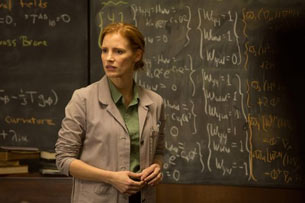
Topped with another winning theatrical score from the masterful Hans Zimmer, Interstellar is an incredible cinematic experience. In many ways, however, the movie is still much too long, but the length does serve the story well, to be fair. Also, the length allows for a lot of very slow moments and there really isn't a lot of action in the film, but it's a visual wonder and a fantastically acted and executed sci-fi film. The themes are heavy on the weight of love and the bonds humans have, especially family, and it'll give cinephiles a lot to sit and discuss afterward. Nolan continues to deliver excellent stories, even if they aren't for every moviegoer. Interstellar certainly soars beyond the norm.
It's seriously crazy to me to think Interstellar is 10 years old already. It's a timeless sci-fi film that holds up well a decade later, and I'm glad to see it getting a lot of love right now -- even being awarded a return to IMAX screens across the country (and packing the seats surprisingly well, too). With director Christopher Nolan taking home Oscars for Best Director and Best Picture for last year's Oppenheimer, it comes as no surprise to see his older movies getting renewed attention.
As far as the movie in 4K UHD, it looks great, yes, but I was surprised by some shots and close-ups that look somewhat out of focus. I'm sure it was something Nolan wanted, but it's something you don't expect from Ultra HD. Chunks of the movie look great, but not too much better than Blu-Ray. However, when IMAX cameras were clearly used in filming, and the aspect ratio fills the TV screen for those shots, the 4K transfer really shines. All in all, it's a good movie to see in this format.

Interstellar 10th Anniversary Limited Edition - 2024's new 4K/Blu-Ray/Digital combo 10th Anniversary set celebrates the film with a box set that offers some fun extras. Director Christopher Nolan had a hand in putting this set together, so fans can expect what they get to have his official seal of approval. The collection comes in an ultra-wide box that won't be very easy to fit on a shelf with the rest of your disc releases. It reminds me a lot of the James Bond anniversary box set, as well as the box set for Ben Hur (the latter of which was super bulky). They're really neats sets in their own right, but they're likely to leave you with a real storage situation. There's an exclusive note from Nolan when you open the insert inside the box. The insert itself is cardboard and includes a pocket on the left side for some small reproductions of five different theatrical posters for the film, and a collection of storyboards for the "Miller's Planet" sequence in book form. Surprisingly, while most box sets and steel books use that removable gummy glue to stick on a sheet that details the set's contents on the back, the one for this box set is actually hiding the included uniform patch reproductions. It doesn't quite fit inside the box, so they attached it to the outside and have the whole thing shrinkwrapped together. They're nice looking patches, though, and probably would look great on display as-is, but you technically could also slap them on a backpack or messenger bag if you wanted to. My biggest complaint with the box set, though, is housing the discs in ultra-tight cardboard cut-out sleeves built into the cardboard insert. I had a heck of a time getting out the feature film 4K disc, and was afraid of ripping the pocket it was in. When I did finally get it out, I had smudged up the edge of the disc. There's just no way to avoid that here. At least with sets that have disc trays, you can usually pop the disc out without ever touching the bottom of it.
There are no special features on the 4K disc, so there's a bonus Blu-Ray disc that includes previously released extras, as well as a brand new 20-minute retrospective about the movie...
The Future is Now: A Look Back at Interstellar (23:16) - While director Christopher Nolan does briefly comment on looking back on this movie, the most unique thing about it is we get to hear from other acclaimed directors, like Denis Villeneuve (The new Dune series) and Peter Jackson (The Lord of the Rings), who just adore the film. Denis even shares that it's a movie his family has revisited over and over together through the years. Nolan comments that the movie wasn't received as well as he'd hoped, but it had been the right film for him to make at the time (his daughter even has a cameo). Nolan's brother Jonathan had been tasked with writing the movie, and we hear from him about the project, as well as from Kip Thorne who helped make sure the science of the movie was sound. Some great behind-the-scenes footage is mixed in, and we get to hear more from other members of the production crew, as well as actor Josh Hartnett, who wasn't in Interstellar, but did star in Nolan's Oppenheimer. Overall, this is a great featurette - exclusive to this release - only, I'm a bit surprised none of the core cast, like Matthew McConaughey, Anne Hathaway, or Jessica Chastain were interviewed here. (2 "S" words from Jonathan and 1 "a" word).
So is the Interstellar 10th Anniversary Limited Edition worth the fuss? That kind of depends on how much you value the extras that are included. If this was one of my absolute top movies, I'd probably want this set just for its uniqueness and few exclusive goodies. However, casual fans will probably not want to fork over the higher price tag for a bigger box, storyboards of one scene, mini movie posters and some patches.
The Blu-Ray pack has lots of fun extras for fans to go deeper than the film itself, and if you're super pumped about the film, you'll love every inch of these extras. The first disc has absolutely no special features on it, so everything's on the second, bonus disc.
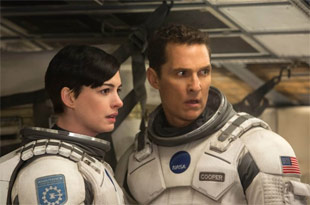
70mm Film Cell - Each specially-marked package includes a real, bonafide film cell from a 70mm transfer of the film! Ours was a shot from the water planet (Miller's Planet) with the Ranger vehicle floating in the water. It's framed in a cardboard sleeve and is a pretty neat freebie. Of course, it's probably only good if you have a place to display it, but it's a nice extra nonetheless.
Blu-Ray, Disc Two: Special Features
The Science of Interstellar (50:20) - This near-hour-long featurette (no doubt ready for air on TV--especially since it feels like a TV special) delves deep into the scientific nature of the movie. Theoretical physicist Kip Thorne consulted on the movie with the Nolan brothers and we hear from him here about his beliefs on gravity and space time and how it plays into the movie. Both Jonathan and Chris Nolan talk about it here as well. The whole feature is also narrated by the film's lead, Matthew McConaughey. It's really geared towards science fans and those really interested in the theories explored in the film. Another expert talks about the search for new planets to replace Earth some day, while Thorne delves further into the concepts of black holes. Overall, only those really interested in the science of all of this will be interested. For me, personally, I found the making-of the film material to be far more interesting.
Inside interstellar Plotting An Interstellar Journey (7:49) - The massive Inside Interstellar section is split up into many separate chapters with no Play All option. The first one talks about how the Nolan brothers got on board and developed the story together. It also addresses approaching the project from a practical view, filming wise, and what it was like shooting in IMAX -- for which one of the camera operators just grabbed the massive camera and used it as a handheld, which is totally unheard of to do.
Life On Cooper's Farm (9:43) reveals that they scouted a wide open location (which was also used in the original Superman movie!) for building the farm house from scratch and the challenges of growing the corn fields. Nolan also talks about the challenges of filming a car driving through a corn field where you can't see immediately in front of you (so they used a remote helicopter to give the driver orders of where to go!).
The Dust (2:38) - We find out here that the dust in the film, which there was TONS of, was a natural substance used for making food -- so it was fake dust. The crews ended up using huge fans to blow it around... and sent in cleaning crews to clean it away when they were done filming!
Tars and Case (9:27) - This is a really interesting segment that talks about how they created the "robots" of T.A.R.S. and C.A.S.E., the former of which was voiced by actor Bill Irwin. More fascinating is that Nolan sought to find out how to create practical effects for them, and had Irwin actually puppeteer real, metal versions of the characters. However, the more intricate stunts -- like it spinning around -- were accomplished using CGI.
The Cosmic Sounds of Interstellar (13:40) - If you love movie scores and/or Hans Zimmer, this is a wonderful featurette that's also extremely interesting. Chris pitched the concept of the movie to Hans by telling him it's about the relationship between a father and son, giving him only a page or so of dialog. Hans then wrote the core theme of the film based on his own thoughts about his own son, and then Chris revealed to him that it's a big sci-fi film. We also learn that an accomplished organist created some of the more intricate pieces as they recorded the music in a real church with an authentic pipe organ. This featurette will really give you a lot to appreciate about the movie's score!
The Space Suits (4:31) - Here they talk about how the space suits were based on real NASA materials and were made to be practical and not just cool looking. They also weighed 30 to 35 pounds and were really hot, so the cast would wear cooling shirts underneath, piping ice water through the suits to cool them down.
The Endurance (9:24) is about the main spaceship the crew flies. We're given a real neat set tour, showing all the practical elements of the set and its features. They also talk about shooting in IMAX in such an unreasonably small space.
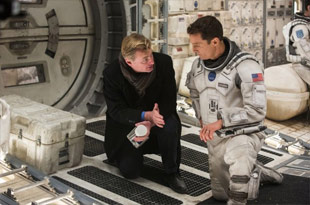
Shooting In Iceland: Miller's Planet / Mann's Planet (12:42) takes us to Iceland, where Nolan shot scenes for Batman Begins almost a decade earlier. Here they found portions of Iceland to double as Miller's Planet -- which was all water, and Mann's Planet -- which was all ice. They also talk about how harsh the conditions were to film in, and how they built outdoor sets right into the glaciers!
The Ranger and the Lander (12:20) is about the designing of the smaller "away" ships that the crew take to the planets. They were constructed out of foam and steel for the on-location shooting, but when they were done, Chris Nolan got the idea to have them mounted on gimbals in a studio to film some unique space flight footage. We also see some great effects pass shots here showing how they accomplished this in the finished film!
Miniatures In Space (5:29) - Here we see some miniatures being built and filmed for the spaceships and space stations. We see some more cool effects passes, as well as them filming some of the miniatures being blown up.
The Simulation of Zero-G (5:31) - Nolan reveals here how they accomplished the look of zero gravity using wires and camera angles and by moving the sets. The actors also talk about what it was like and how it could sometimes be really difficult.
Celestial Landmarks (13:22) - Kip Thorne shows up again here to talk about space and time and what a real wormhole might look like. He also admits that the filmmakers designed what he believes is what a real wormhole would look like.
Across All Dimensions and Time (9:02) - This is a super cool featurette that talks about the finale in the film and the science of it. The finale looks like it's probably all CGI in the finished film, but here we learn that a good portion of it was built as a real set -- which is just amazing!
Final Thoughts (6:02) - The cast and crew talk about the science of the film and their hopes that it'll inspire people to want to explore space, and the theories of the film, in the future.
Trailers - The final main section includes the original theatrical teaser trailer and 3 different regular trailers for Interstellar.
- John DiBiase, (reviewed: 3/28/15)
Disclaimer: All reviews are based solely on the opinions of the reviewer. Most reviews are rated on how the reviewer enjoyed the film overall, not exclusively on content. However, if the content really affects the reviewer's opinion and experience of the film, it will definitely affect the reviewer's overall rating.
 Worship Leader Jonathan Nelson Inks Recording Deal with Tyscot Records Worship Leader Jonathan Nelson Inks Recording Deal with Tyscot RecordsSun, 04 Jan 2026 21:30:00 EST |
 Nineties Worship Night, Johnny B, Crossroads Creative Release "I Give You My Heart" Cover Nineties Worship Night, Johnny B, Crossroads Creative Release "I Give You My Heart" CoverFri, 02 Jan 2026 18:05:00 EST |
 TCM Celebrates 27 Years of Charting Australia's Christian Music Hits TCM Celebrates 27 Years of Charting Australia's Christian Music HitsThu, 01 Jan 2026 18:10:00 EST |
 8x Grammy Nominated Gospel Great Richard Smallwood Dies at 77 8x Grammy Nominated Gospel Great Richard Smallwood Dies at 77Tue, 30 Dec 2025 12:40:00 EST |
 HIS Hypeman Stract and Daniel DeGree Prove There Are Levels to This Life HIS Hypeman Stract and Daniel DeGree Prove There Are Levels to This LifeMon, 29 Dec 2025 19:10:00 EST |
 "HOPE" is Coming, Petra's First New Studio Album in 20 Years "HOPE" is Coming, Petra's First New Studio Album in 20 YearsWed, 24 Dec 2025 13:30:00 EST |
 John Schlitt Releases Limited Vinyl Edition of "The Christmas Project" John Schlitt Releases Limited Vinyl Edition of "The Christmas Project"Tue, 23 Dec 2025 18:00:00 EST |
 Click here All News Headlines |
Click here All News Headlines |